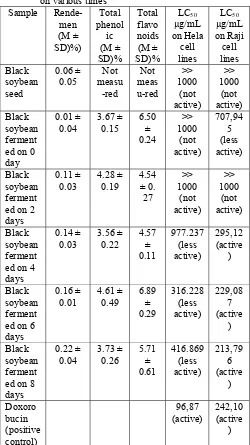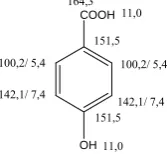Phenolic content and cytotoxic properties of fermented black soybeans
(
Glicine soja)
extract on human Hela-S3 and Raji cell lines
S. Atun
1*, R. Arianingrum
1, T. Yoshiaki
2and N. Masatake
21
Department Chemistry education, Universitas Negeri Yogyakarta, Karangmalang, Depok, Sleman, Yogyakarta, Indonesia 55281
2
Faculty of Pharmacy, Meijo University, Tempaku, Nagoya, Japan
*E-mail: [email protected]
Abstract:The purpose of this research are to determine
total phenolic and flavonoids content from fermented black soybeans (Glycine soja) on various times (0; 2; 4; 6; and 8 days) by the micelium of Rhizopus oligosporus, the cytotoxic activity test on human cancer such as Hela S3 and Raji cell lines, and isolated the phenolic compounds from fermented black soybean.Total phenolics and flavonoids from some methanol extracts were determined by spectroscophy. The isolation of this compound was carried out by chromatographic method, whereas structure elucidation was performed by interpretation of spectroscopic data, including UV, IR, 1H and 13C NMR. The research showed that the highest content of total phenolic and flavonoids were found in 6 days fermented black soybean, which also displayed the highest cytotoxic activity against Hela S3 and Raji cell lines. Isolation and structure elucidation of phenolic compounds from fermented black soybean had also been done. From methanol extract of 4 days fermented black soybean, we isolated one known compound namely p-hydroxybenzoat.
Introduction
Cancer or tumor is one of the dangerous diseases nowadays. And until know, the medicine of this disease have not been found yet. So, the efforts to find the medicinal compounds which can be used to prevent and therapy cancer are needed [1]. It has been reported that black soybean is a type of soybean (Glycine max) with a black seed coat, contained numerous bioactive compounds and show radical-scavenging activity, anti-tumor activity and activity for improving the fluidity of the whole blood. The seeds of Glycine max (L.) Merr. (soybean) belongs to family Fabaceae is being used in Asia for many centuries to prepare a variety of fresh, fermented and dried foods [2-5]. It is one of the most economically important crop for the major source of high-quality protein and vegetable oil for animal and human nutrition in the world [5]. Seeds contain high amount of components with health benefits, such as proteins, isoflavones (genistein, daidzein, and glycitein), coumestrol, phytate, saponins, lecithin, phytosterols, vitamin E and dietary fiber. Isoflavones have been reported to play essential role in hyperlipidemia, cardiovascular diseases. Dietary fiber plays an important role in the reduction of cholesterol levels in some hyperlipidemic individuals [3-11]. The purpose of this research are to identification total phenolic and flavonoids content from fermented black soybeans (Glycine soja) on various times (0; 2; 4; 6; and 8 days) by the micelium
of Rhizopus oligosporus, the cytotoxic activity test on human cancer such as Hela S3 and Raji cell lines, and identification the phenolic compounds from fermented black soybean.
Materials and Methods
Preparation of fermented methanol extract of black soybeans
The seeds of black soybeans (Glycine max) were purchased from local market in Bantul, Yogyakarta, Indonesia in February 2009. The seeds of black soybeans were identified by a staff at Department of Biology, UGM, Indonesia. The black soybeans were macerated for 24 hours, boiled for 2 hours, and then it was remacerated while peeling the seed coat, and washed it until clean. Next, the peeled black soybeans were boiled, and let it cool in a room temperature. After it was cool enough, approximately 2% of Rizopus oligosporus was added and wrapped it by using banana leaves. Then, it was fermented in 0; 2; 4; 6; and 8 days. The fermented black soybean was milled and added some methanol. As a result, the filtrate was collected and evaporated by using vacuum evaporator, so that we could get crude extract.
Determination of total phenolic and flavonoids content
Total phenolics were determined by the Folin-Ciocalteu procedure [12]. Aliquots (0.1 mL) of aqueous methanol extracts were transferred into test tubes and their volumes made up to 0.5 mL with distilled water. After addition of Folin-Ciocalteu reagent (0.25 mL) and 20% aqueous sodium carbonate solution (1.25 mL), tubes were vortexed and after 40 min the absorbance of the resulting blue colored mixtures was recorded at 725 nm against a blank containing only extraction solvent (0.1 mL). The amount of total phenolics was calculated as a galic acid equivalent from the calibration curve.
For the determination of flavonoids, powdered plant material (1 g) was homogenized with extracting solvent (140:50:10 MeOH-H2O- CH3COOH, 20 mL) and filtered into volumetric flasks. Volumes were adjusted to 100 mL by addition of additional extracting solvent. To prepare the solutions for analysis aliquots (2.5 mL) were transferred into 50 mL volumetric flasks and their volumes made up with water. To each 10 mL of analysis solution, water (2 mL) and AlCl3
689
reagent (133 mg crystalline aluminium chloride and 400 mg crystalline sodium acetate dissolved in 100 mL of extracting solvent, 5 mL) were added and absorbances recorded at 430 nm against a blank (10 mL of analyzed solution plus 5 mL of water). The amount of flavonoids was calculated as a rutin equivalent from the calibration curve of rutin standard solutions, and expressed as g rutin/kg plant material [13].
Measurement of cytotoxic activity
All of methanol extracts we evaluated for in vitro
cytotoxicity against a panel of human tumor Hela S3 and Raji cell lines. The in vitro cytotoxicity test was investigated using plate with 96 wells, with cell density 2x104 cells per mL. Into each well was added 100 µL cells in culture medium (87,5% RPMI 10,4 g/L; 2% penstrep; and 10% FBS) which was then incubated in CO2 incubator for 12-24 hours at 370C. Each sample was dissolved in culture medium containing 0,05% DMSO, and 100 ȝL of each sample in different concentrations was added into each well in triplicate and was then incubated in CO2 incubator for 12-24 hours at 37oC. MTT solution (10 ȝL per 100 μl
medium) was added to all wells of an assay, and plates were incubated for 4 hours at 37oC in CO2 incubator. As much as 100 ȝl formazon (10% SDS and 0, 01 N hydrochloric acid) was added into each well and mixed on a shaker for 5 minutes. The wells were incubated in the dark room for 12-24 hours at room temperature. The absorbance was measured using multiwell scanning spectrophotometers (ELISA reader) at 595 nm. The absorbance is directly proportional to the number of living cells. So the dead cell could be calculated to determine LC50. Doxorubicin, a medicine for lymphoma, leukemia and acute tumor, was also measured its cytotoxic activity as positif control comparison. The cytotoxic activity of the samples against Hela-S3 cell measured as LC50 were provided in Table 1. Hela-S3, a continuous cell line that lived as adherent cell, is a cell derivate of ephythell cell of human cervix cancer. Further investigation of cytotoxic activity of the samples was held against Raji cell (Table 1). The cell that resembles lymphoblast cell found by R.J.V Pulvertaft (1963) from Burkitt’s lymphoma at the left of the upper jaw of a 11 year old negro boy.
Isolation phenolic compounds
The isolation of phenolic compounds from methanol extract of 4 day fermented black soybeans was done by using the chromatography. A portion (40 g) of the total methanol extract was fractionated by vacuum liquid chromatography (VLC) and purified by repeated column chromatography on silica gel eluted with various solvent systems. From this method we obtained one phenolic compounds, namely p-hydroxybenzoat (1) (30 mg). The structures of these compounds were established on the basis of their spectral data, including UV, IR, and NMR spectra.
Results and Discussion
The result of methanol extract of fermented black soybeans (Glycine soja) on various times can be seen on table 1. Rendemen methanol extract from fermented black soybean on various times show an increased, because that the more time we fermented the soybean, the more big compounds (polymer) which hydrolyze, so that it can easily soluble in methanol. The highest total phenolic and flavonoid were found in 6 days fermented black soybean, which also displayed the highest cytotoxic activity against Hela S3 and Raji cell lines.
Table 1: Rendemen methanol extracts, total phenolic content, total flavonoids, and cytotoxic activity against Hela S3 and Raji cell lines of fermented black soybeans (Glycine soja) on various times
From the methanol extract of 4 days fermented black soybeans, after separated and repeatedly purification by extensive chromatography were
690
resulted one compound. Compound 1 was obtained as a white yellow powder, maxima of absorption were observed at 250 and 285 nm in the UV spectrum attributable to the phenol chromophor. The IR spectrum exhibited hydroxyl group (3445 cm-1), C=O (1730; 1718 cm-1), and C=C aromatic (1670-1454 cm -1
). The 1H NMR spectra showed two sets of AA’BB’ system of aromatic protons assignable to 1.4-disubstitutedbenzene at δ 5.45 (2H, d, J = 8.5 Hz)
ppm and 7.38 (2H, d, J = 8.5 Hz). They also displayed two signal protons at δ 11.0 (2H, br s) exhibited of
hydroxyl proton from phenol and carboxyl fungsional group. The 13C NMR spectrum showed four signal carbon which exhibited of seven carbon atom. Furthermore, 7 signal carbon showed 1 carbon oxyaril at δ 164.3 (1 C) ppm, one carbon quarterner at δ 151.4
(2C) ppm, 4 carbon metin at δ 142.1 (2C) and δ
100.17 (1 C) ppm. Spectrum NMR (1H and 13C) of 1 has similar with p-hydroxybenzoat (Fig. 1). The isolation of the other compounds has been doing in my laboratory.
Some phenolic compounds have been isolated from soybean seeds such as chlorogenic acid, caffeic acid, ferulic acid, and p-coumaric acid. These have antioxidant effects that are beneficial to human health. Generally, these phenolic acids have contents ranging from 28 to 72% of the total phenol level in soybean seeds [4]. Many phenolic compounds found in plant tissues are potential antioxidants: flavonoids, tannins and lignin precursors may all work as ROS-scavenging compounds. The effects of dietary phenolics are of great current interest, due to their antioxidative and possible anticarcinogenic activities. A popular belief is that dietary phenolics are anticarcinogens because they are antioxidants, but direct evidence supporting this supposition is lacking [11]. Phenolics may inhibit carcinogenesis by affecting the molecular events in the initiation, promotion, and progression stages. Isoflavones and lignans from soybean may influence tumor formation by affecting estrogen-related activities. They also modulate the growth of benign and malignant prostatic epithelial cells in vitro [10].
Conclusions
The highest content of total phenolic and flavonoids were found in 6 days fermented black soybean, which also displayed the highest cytotoxic activity against Hela S3 and Raji cell lines. From methanol extract of 4 days fermented black soybean,
we isolated one known compound namely p-hydroxybenzoat.
Acknowledgements
This work was supported by Indofood Research Nugraha 2009 (Indofood Sukses Makmur Tbk) Indonesia.
References
[1] Auroma O.I, J. Nutr. Biochem.Vol.5 (1994), p 370-381 [2] Dixon RA, Steele CL, Trends Plant Sci, 4, (1999), p394
-400
[3] Galati G, O'Brien PJ., Free Radic. Biol. Med., 37(3), (2004), p287-303
[4] Kim E.H, Kim S.H, Chung J.I., Chi H.Y., Kim.J.A. Chung I.M., Eur Food Res Technol.222, (2006), p201-208
[5] Jha, H.C. Asian Symposium Non-salted Soybean
Fermentation, Tsukuba, Japan, July 14-16., (1985)
[6] Lim H, Park H, Kim HP, Arch. Pharm. Res, 27(4), (2004), p 442-8.
[7] Moyers SB, Kumar NB, Nutr. Rev., 62(5), (2004), p 204-11.
[8] Murakami, H., Asakawa, T., Terao, J. dan Matsushita, S.
Agric. Biot. Chem., 48 (12), (1984), p 2971-2975.
[9] Murata, K, Asian Symposium on Non-salted soybean
fermentation, Tsukuba, Japan, July 14-16, 1985.
[10] Ralston L, Plant physiology, vol. 137, (2005), p 1375-1388
[11] Malencic D., Milan P., Jegor M., Molecules, 12, (2007), p 576-581.
[12] Hagerman, A.; Harvey-Mueller, I.; Makkar, H.P.S.
Quantification of Tannins in Tree Foliage Laboratory
Manual; FAO/IAEA: Vienna (2000).
[13] Marckam, K.R. 1989.Methods in Plant Biochemistry; Academic Press: London, (1989).
COOH
OH
164,3 11,0 151,5
142,1/ 7,4 100,2/ 5,4
151,5 11,0 100,2/ 5,4
142,1/ 7,4
Figure 1. Structure of p-hydroxybenzoat
691

